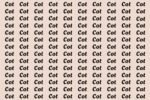Have you ever tried spotting a particular word hidden among similar-looking ones? It’s a simple challenge, but it can reveal a lot about how our brains process information quickly and accurately. One of the most intriguing examples is the task of spotting the word “FLAG” among many similar-looking words like “FALG,” “FLGA,” or “FALGs.” This exercise is a fascinating test of attention to detail, pattern recognition, and cognitive speed.
The Science Behind Word Recognition
At first glance, reading might seem like a straightforward task we see letters, form words, and understand meaning. But the reality is much more complex. Our brains engage in a rapid process involving visual recognition, linguistic knowledge, and even predictive guessing. When asked to find a specific word like “FLAG” among similar variants, several mental mechanisms come into play.
Visual processing in the brain identifies letter shapes, but it also takes context into account. For example, when letters appear in the expected order, recognition is faster because our brain anticipates the correct pattern. When letters are scrambled or swapped, the brain has to work harder, slowing down recognition. This is why spotting “FLAG” among “FALG” or “FLGA” can be surprisingly tricky, even though the letters are the same.
Attention and Focus Are Key
Another factor influencing how fast you can spot “FLAG” is your level of attention. When you focus intently on the task, your brain filters out distractions and hones in on the relevant information. This selective attention improves speed and accuracy. However, if you’re distracted or trying to multitask, your ability to spot the correct word diminishes.
This phenomenon is related to what psychologists call “attentional control.” The better you can control where your attention goes, the more efficiently you can process visual information. So, when playing spotting games or doing puzzles, concentrating fully can make a big difference.
The Role of Pattern Recognition
Our brains are incredibly skilled at recognizing patterns, especially when it comes to language. Through years of reading and exposure to words, we develop an internal “dictionary” that helps us quickly identify familiar letter combinations. The word “FLAG” is common enough that most people’s brains have a strong template for it.
When presented with jumbled versions like “FALG,” the brain notices the disruption in the familiar pattern, which slows down recognition. On the other hand, if the letters appear in the right order, even if surrounded by similar jumbles, your brain picks it out faster because it matches an internal pattern stored in memory.
Why Does This Matter?
Understanding how we spot words like “FLAG” among similar variants isn’t just a fun brain teaser; it has real-world implications. For example, in reading education, helping children develop strong pattern recognition and attention skills improves their literacy. In professions like proofreading or quality control, being able to spot small errors quickly is crucial.
Moreover, this kind of task can be a simple way to exercise your brain, improving mental sharpness and focus. Many brain training apps and puzzles use similar challenges to boost cognitive function.
Practical Tips to Improve Your Word Spotting Speed
If you want to get better at spotting words like “FLAG” among similar options, there are some practical techniques you can try:
- Practice regularly. Like any skill, the more you practice, the better you get. Try puzzles and games that involve word recognition and quick scanning.
- Improve your focus. Minimize distractions and work in a quiet environment to maximize your attention.
- Train pattern recognition. Read widely and engage in activities that strengthen your familiarity with common word patterns.
- Take breaks. If you feel your focus waning, short breaks can refresh your brain and improve performance.
- Use peripheral vision. Sometimes, training your peripheral vision helps in spotting words faster in a cluttered field.
Final Thoughts
The challenge of spotting “FLAG” among similar “FALGs” is a small but fascinating window into how our brains process visual and linguistic information. It shows the interplay of attention, pattern recognition, and cognitive speed. Next time you encounter such a challenge, take a moment to appreciate the incredible mental gymnastics involved. And if you want to sharpen your skills, practice and focus will take you far.
So, how fast can you spot the word “FLAG”? Try it out and see for yourself — it might be trickier than you think!




